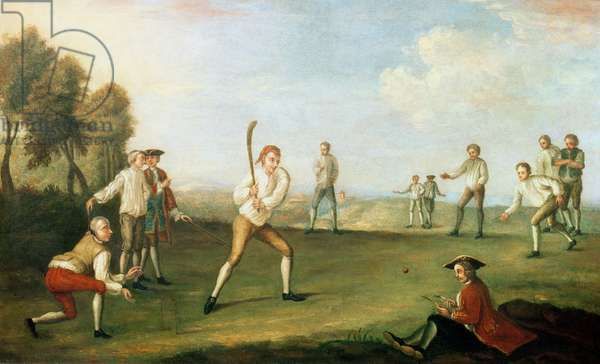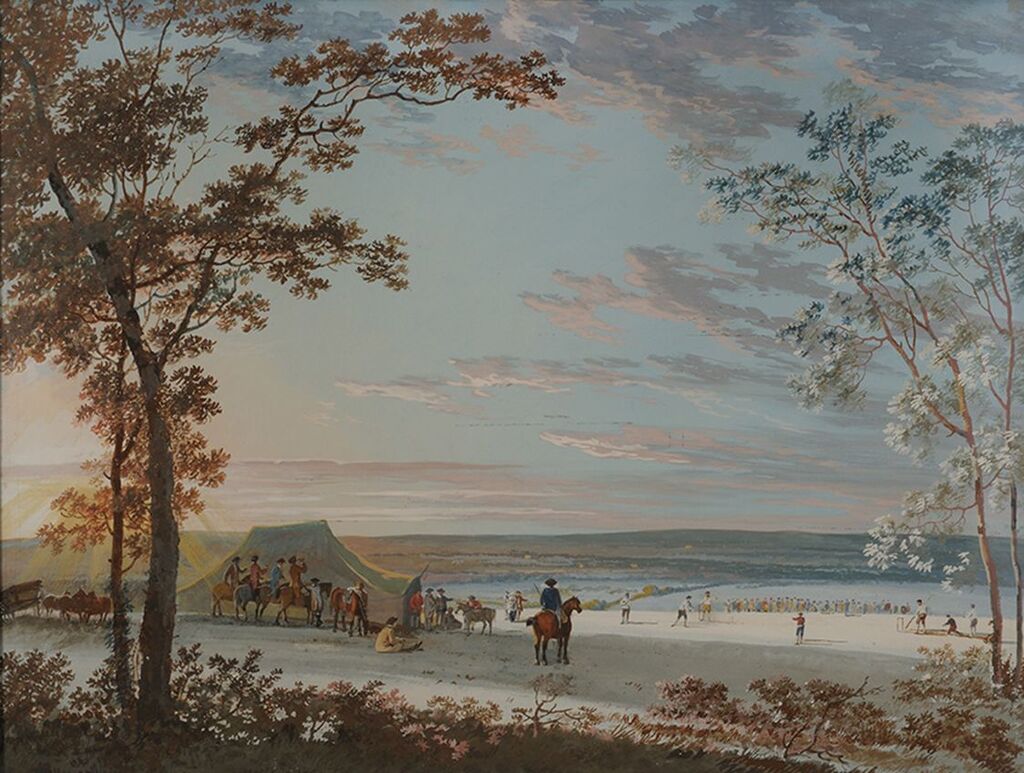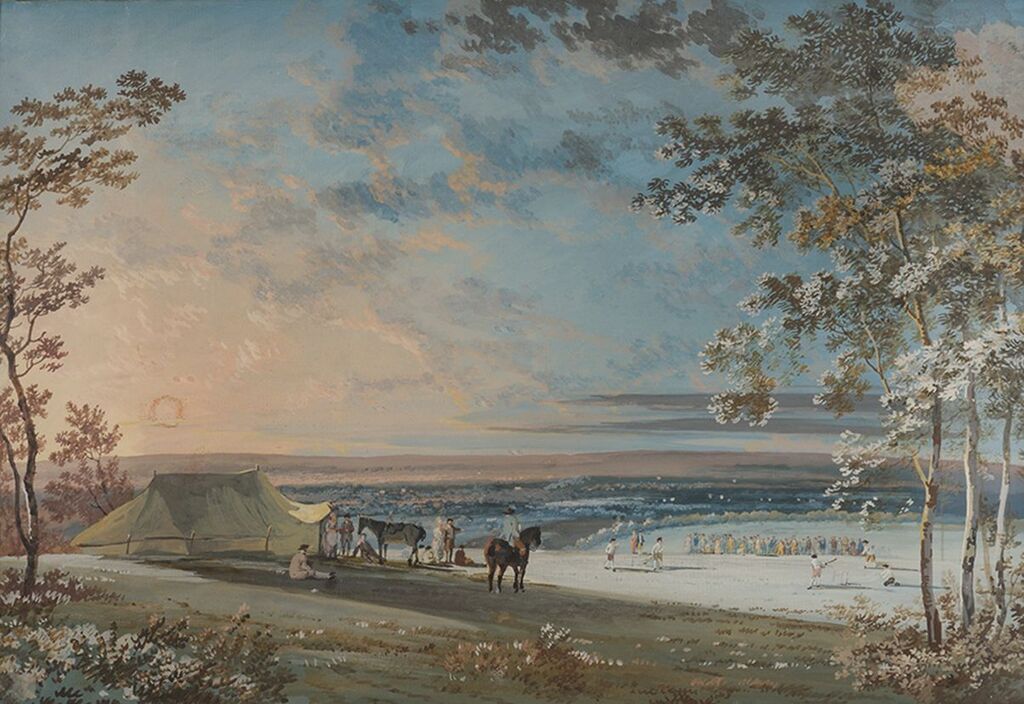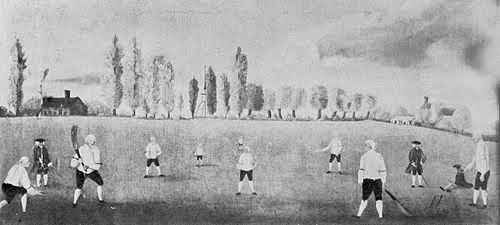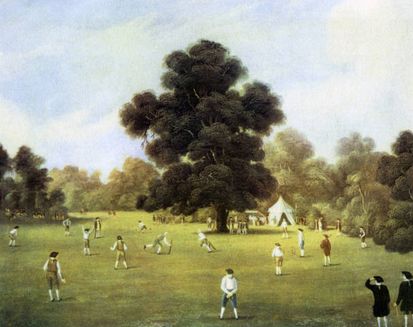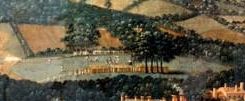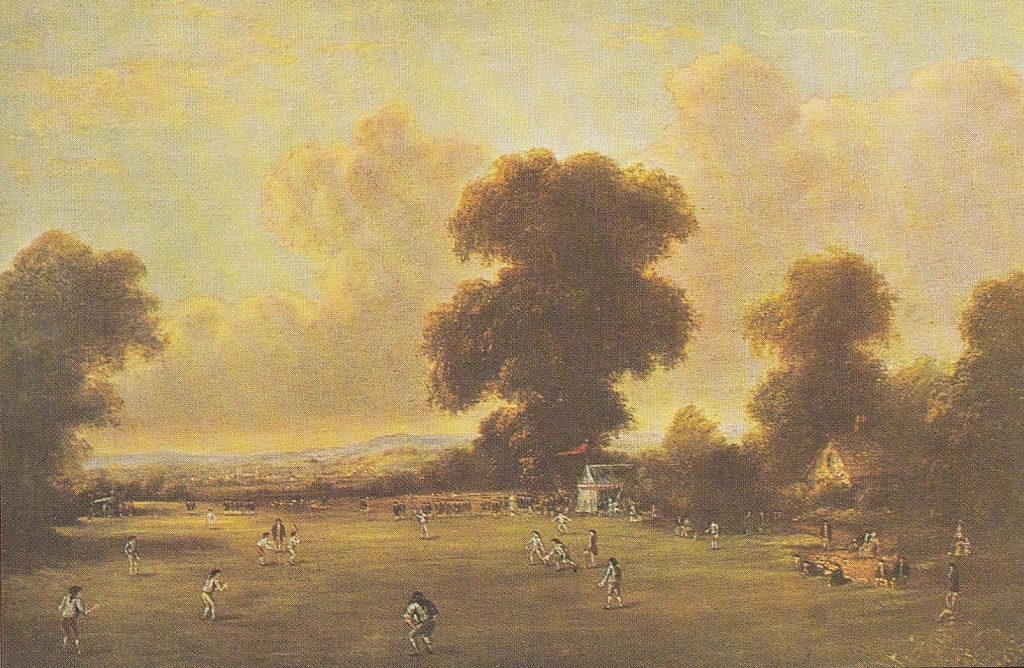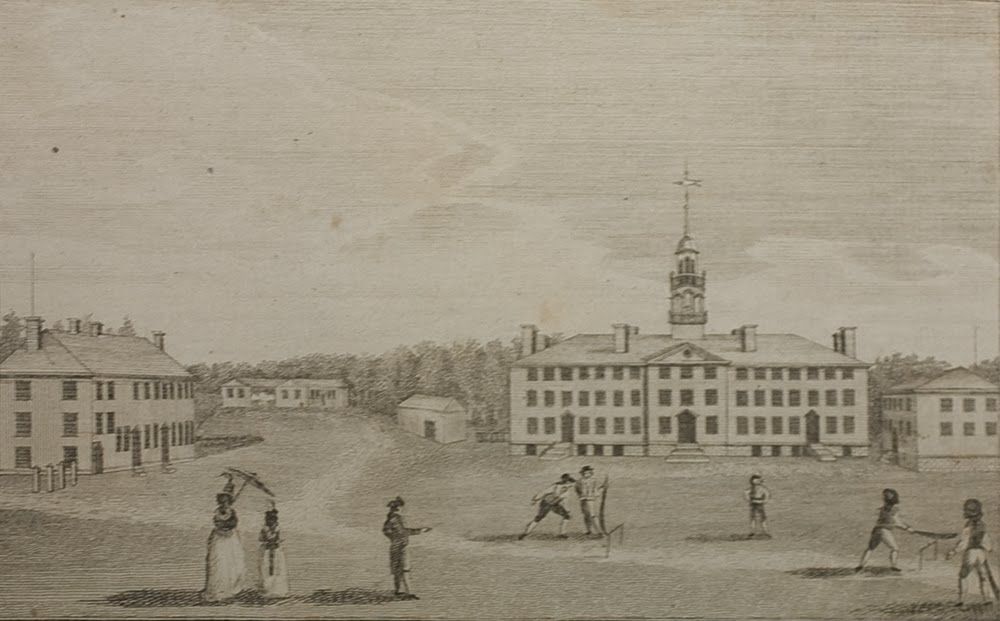Contents
1743 – Cricket at the Artillery Ground – Benoist, after Hayman (1735)

An engraving by C. Benoist, after an Oil painting by Francis Hayman, RA, based on the earliest depiction of a cricket match that we know of; obviously, this is a very important art-work and one that is much copied. The original by Hayman is now lost but used to hang in a supper-box at Vauxhall Gardens (opened 1735).
The painting has come to be known as Cricket at the Artillery Ground but this is a misnomer. The pictures was originally described as A Game of Cricket as played in the Artillery Ground, the Ground of the Honourable Artillery Company being the most famous of its day, and the misunderstanding arose from that. In fact, the Artillery Ground was walled in so this picture is obviously somewhere else. Note, this is a single wicket match, there is only one wicket and one batsman. Also, the hockey-stick bat is being used
1740 – A Cricket Match at Mary-le-bone Fields – Hayman

A hugely important painting by Francis Hayman, the original survives in the MCC collection. Oil on canvas 88 x 108 cm.
The set-up of the game is similar to the painting wrongly associated with the Artillery Ground. Indeed, the arrangement of figures in this painting is reproduced many times throughout the century.
1740 – A View from the Green in Richmond – Heckel
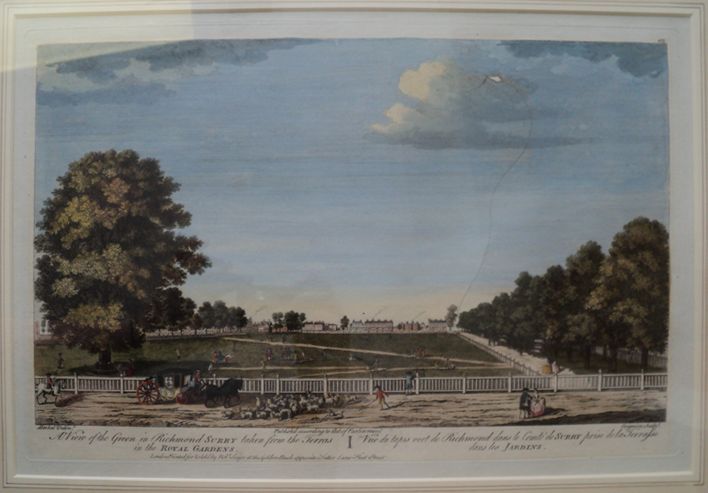
Coloured line engraving of Richmond Surrey, view of the Green, taken from the terrace in the Royal Gardens. A game of cricket is in progress on the green. Artist Heckel. Line engraving by G. Grignon, coloured in body colour. Published by Robert Sayer Fleet Street c.1752.
1741 – Cricket players of Europe – Matthew Darly
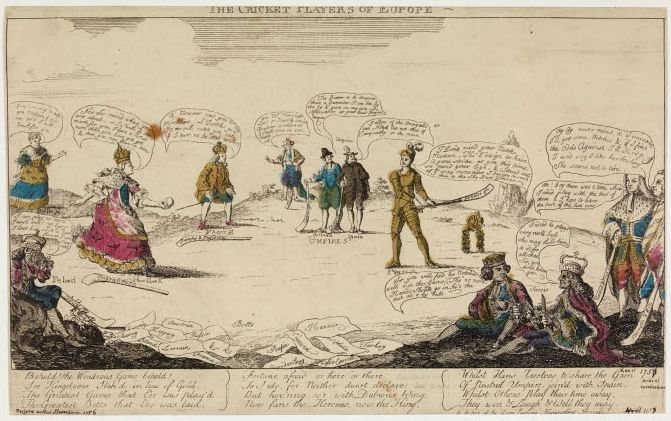
Caricature satirising European Royal families; each character has a speech bubble. There are rhyming verses below the image.
Amazing stuff, it show that the imagery of cricket was already widely recognised. Hockey stick bats on the ground, a shoulderless bat in play – why I wonder…
1743 – Landscape with Cricket Match in Progress – Paul Sandby
1743 – An Exact Representation of the Game of Cricket – after an engraving by Louis-Phillipe Boitard
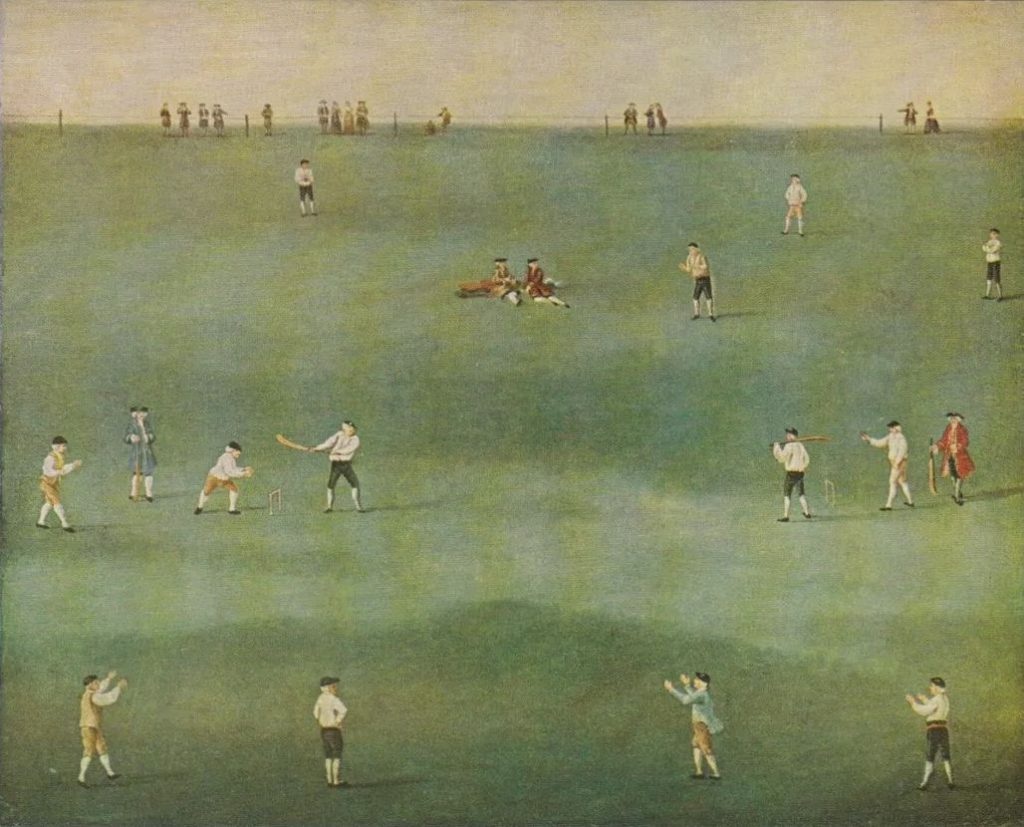
Possibly by WR Coates. The arrangement of the fielders echo Hyman, note especially double-teapot man in the covers, but four leg-side fielders rather than three. The scorers are on the far side of the field but still positioned within the field of play, this seems to have been a common feature of cricket of the time.
The painting is in Tate Britian. See article in The Independent.
1744 – Handkerchief of the Laws of Cricket
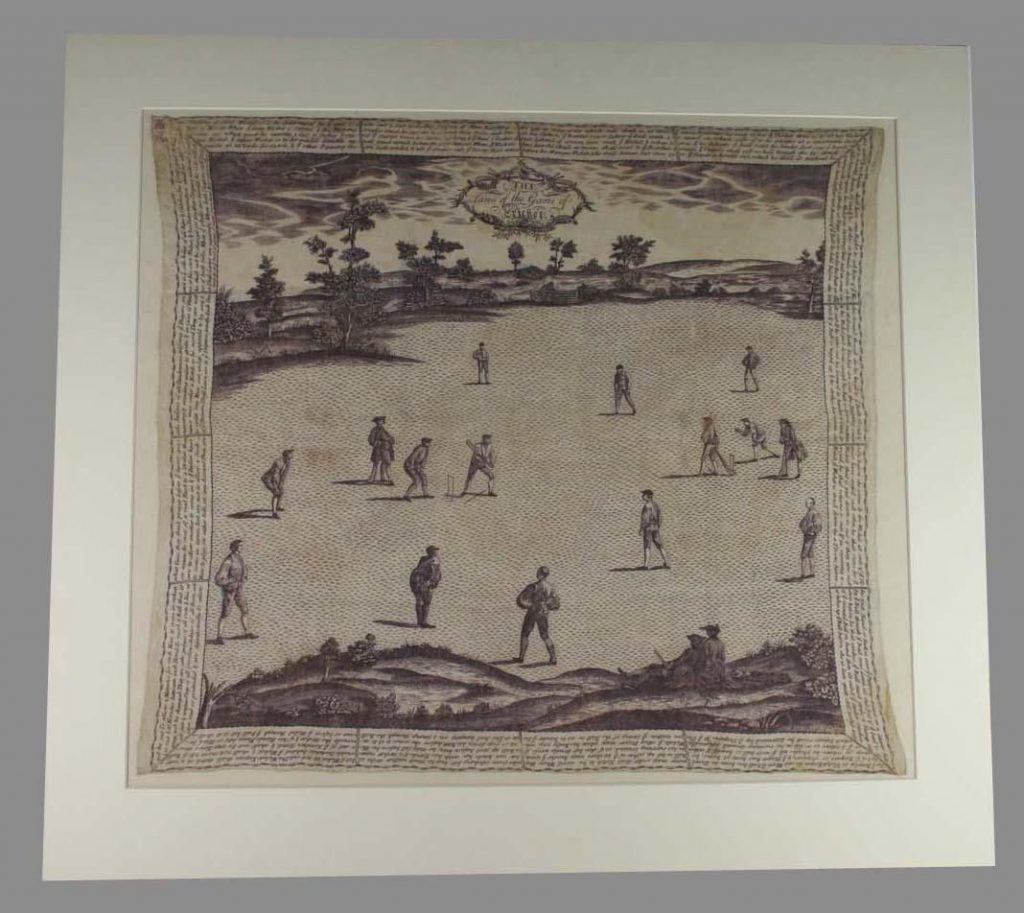
The picture is a straightforward copy of Hayman, the importance of this object is that around the edges are the first laws of cricket we have
1750 – Cricket in Battersea Fields
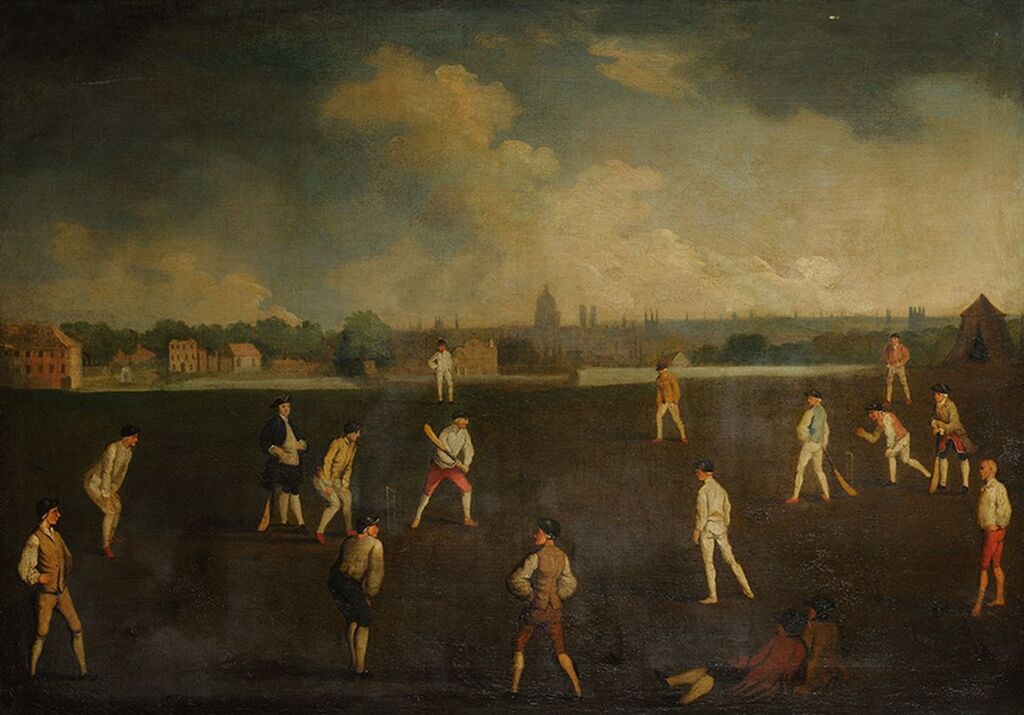
View of London in the distance with many steeples and churches evident. Again, the figures are derived from Hayman, three leg side fielders plus double-teapot-man.
1750 (?) – Cricket Match
1755 – Knowle Park
1761 – Cricket at Brading, Isle of Wight
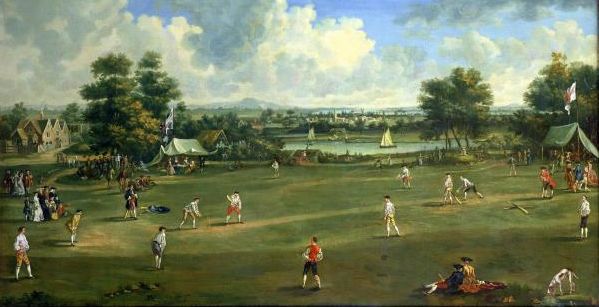
Part of the MCC collection. The cricketers are wearing red, gold or blue breeches. Tents with Union flag on the left and St George’s flag on the right. The arrangement of figures is similar to Hayman (1740), this painting may be a Nineteenth Century pastiche.
c1770 – A Cricket Match on Cotmandene, Dorking – James Canter
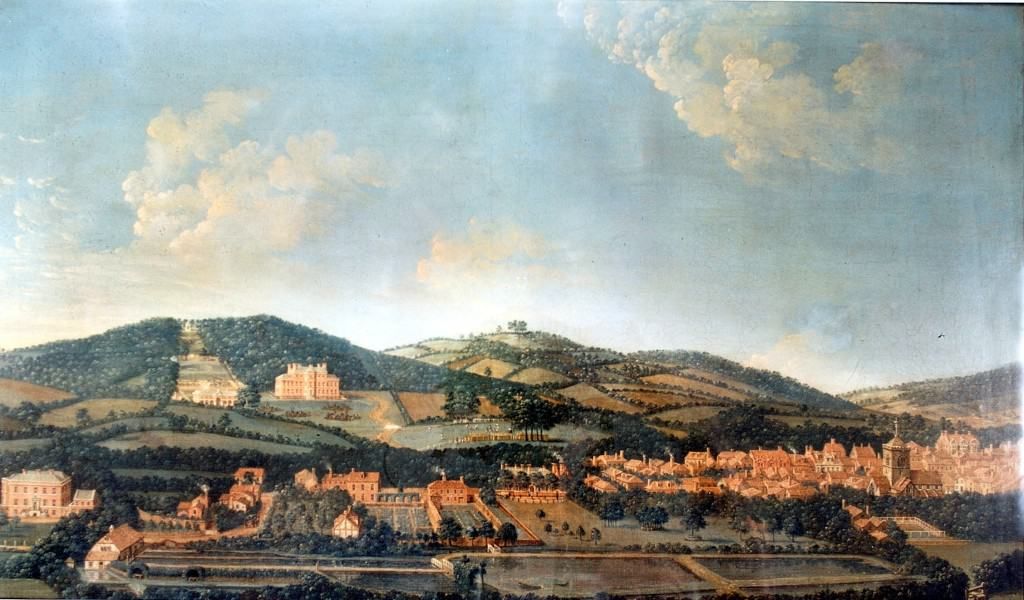
View of the town of Cotmandene, near Dorking with a cricket match in progress in the the centre of the painting, merging into the landscape. On the left side is Deepdene, then the home of James Howard, 11th Duke of Norfolk. Despite its inconvenient slope, Cotmandene continued to be the main venue for cricket in Dorking well into the 19th century, until the establishment of a new ground at Pixham in 1878. The last recorded match at Cotmandene took place in July 1899, between Dorking and an MCC side featuring the novelist Sir Arthur Conan Doyle.
1770 – Cricket at Wincheap, near Canterbury
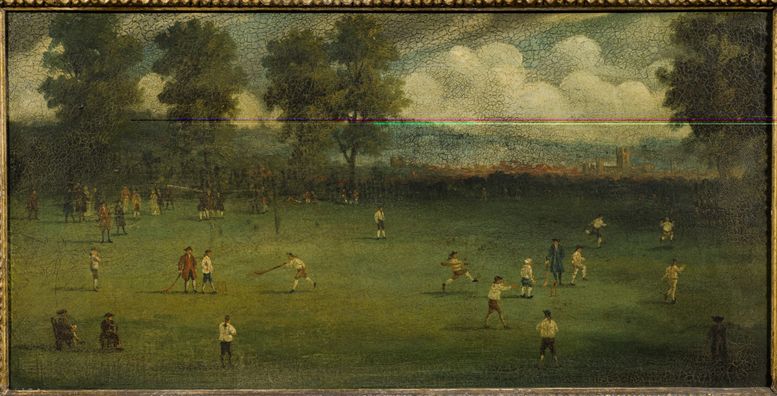
Players with curved bats running between stumps. Canterbury cathedral and town in background.
This is not the current Kent Ground, known as St Lawrence, although this is also in the Wincheap area.
1773 – Kent v Sussex, Sevenoaks Vine
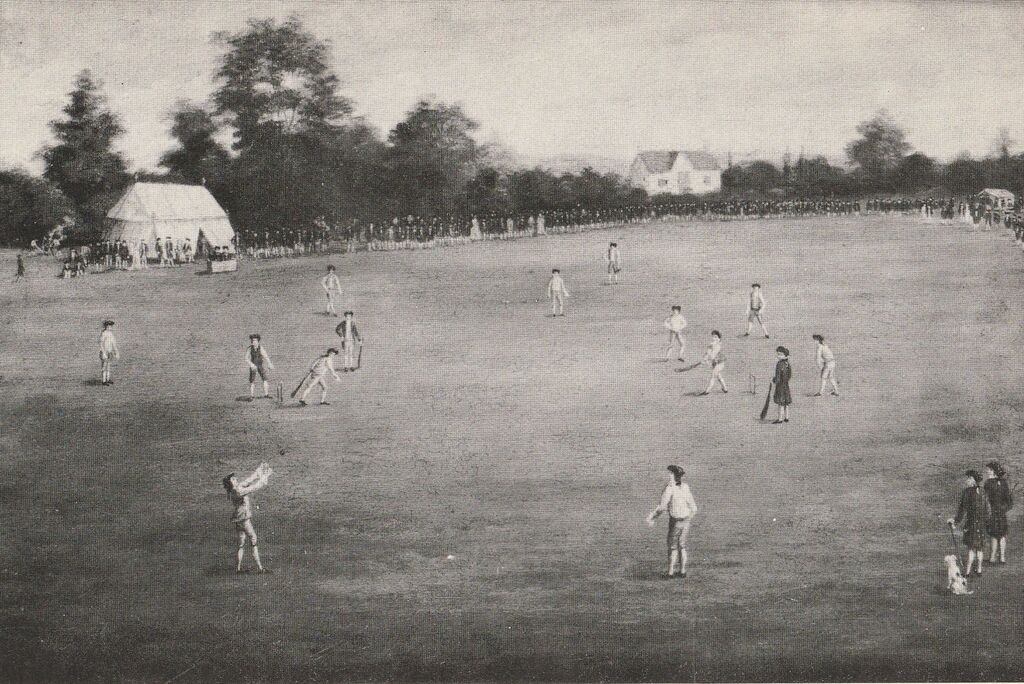
What I love about this painting is that there is genuine action. The leg-side fielder, at what we would now call cow-corner, is poised to take a catch, you can just see the ball close to his hands as he lines himself up. The batsman is rooted to his crease as he awaits his fate. Strangely though, the bowler seems to have disappeared…
1774 – Surrey v Hambledon
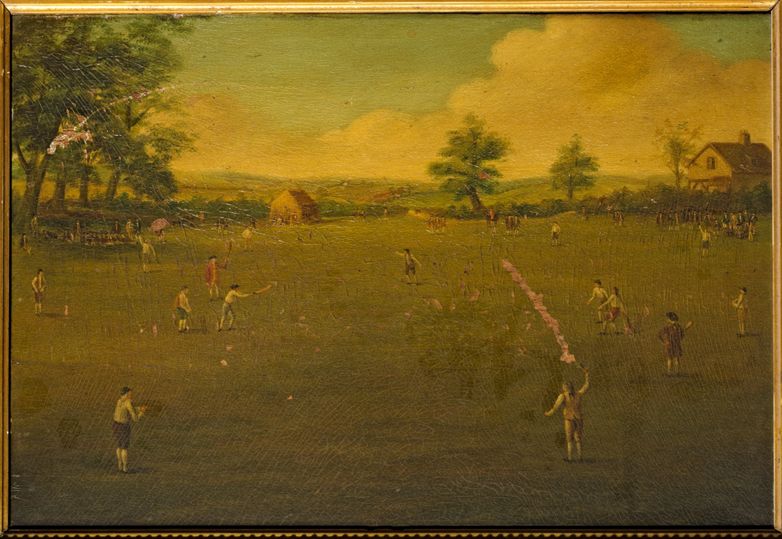
Cricket match in progress on an uneven field. Players wearing breaches and holding curved cricket bats. Oak trees and village in the background.
The layout of the fielders seems to be the painters own, possibly indicating this was an authentic view. Bowling is from the right, a good of the bowler’s run up. Strangely, the bowlers end umpire seems to be stood at a kind of short mid-off. The LBW law came in in 1774, around the time of this painting but was not widely used for many years thereafter. So, the umpire would see little need to line himself up with the wicket
Possibly at Guildford Bason, Merrow Down
1774 – Kent v Hampshire at Bishopstone – Belanger
1779 – The Countess of Derby and friends playing cricket – T.H.

The Countess of Derby and friends playing cricket, 1779, by ‘T.H.’. The only pictures of Eighteenth Century Women playing cricket, but in aristocratic rather than the more usual rural setting. The atmosphere is more of casual play rather than a match – most of the ladies appear to be spectators rather than participants.
1780 – Cricket at Kenfield Hall
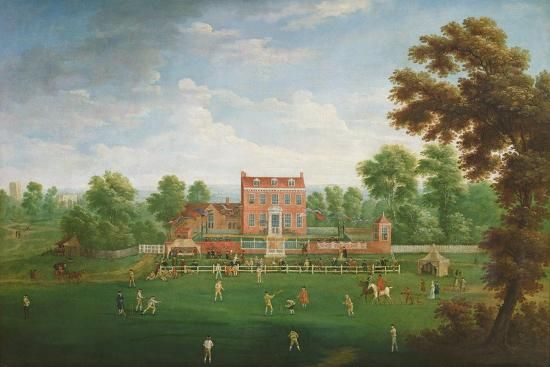
A cricket match in progress in front of a grand red brick house – Kenfield Hall, near Petham, Canterbury. Spectators stand in the garden behind a white fence. A banner with ‘Welcome’ written on it hangs from the wall behind them.
1784 – Harwich with a game of cricket in progress – John Nixon
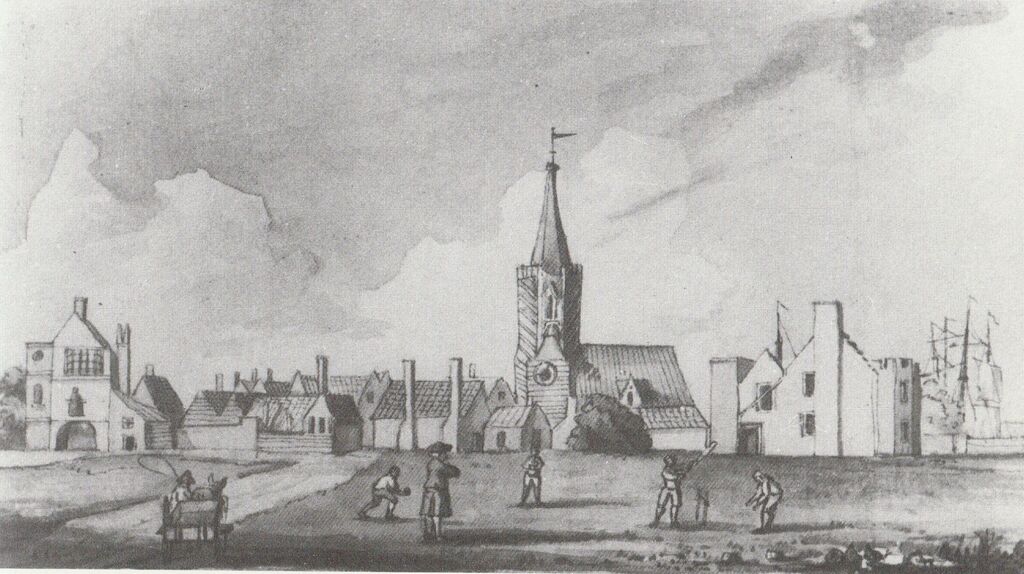
Harwich is an Essex port, tall ships can be seen in the background. The casual play is another indication of the spread and popularity of the game of cricket
1780s – Cricket at White Conduit Fields (1)
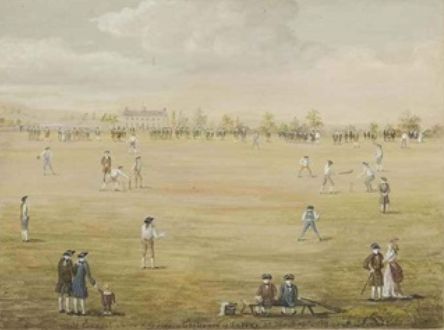
The first of five pictures of White Conduit Fields Ground, this one a South to North view. The large building in the background is the Islington Workhouse.
1784 – Cricket at White Conduit Fields (2) – Robert Dighton
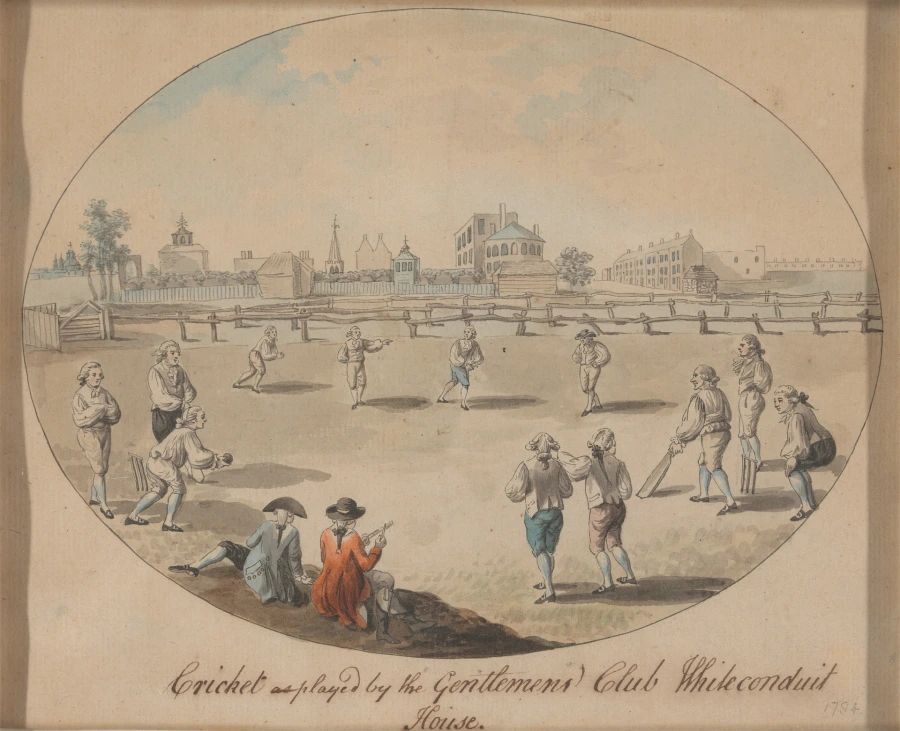
This view of White Conduit Field is from the North to the South – the City of London skyline is prominent. An unusual example of a painting with several identifiable topographic details beyond the field itself. White Conduit House and Grounds were an important 18th Century leisure facility for the less well-off classes. The site of the central building is now on Penton Street, Islington.
1784 – Cricket at White Conduit Fields (3) – engraving
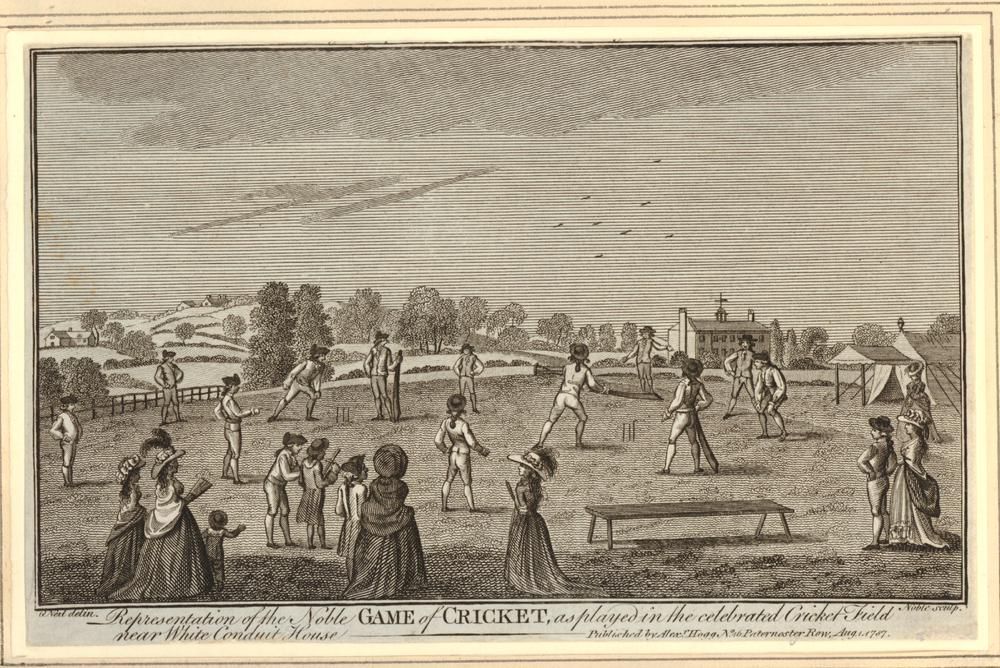
This is a view from South to North, away from the White Conduit building. The large building in the background is the Islington Workhouse. The low three-stump wicket however, was never a feature of the game.
1790 – Cricket at White Conduit Fields (4) – painting
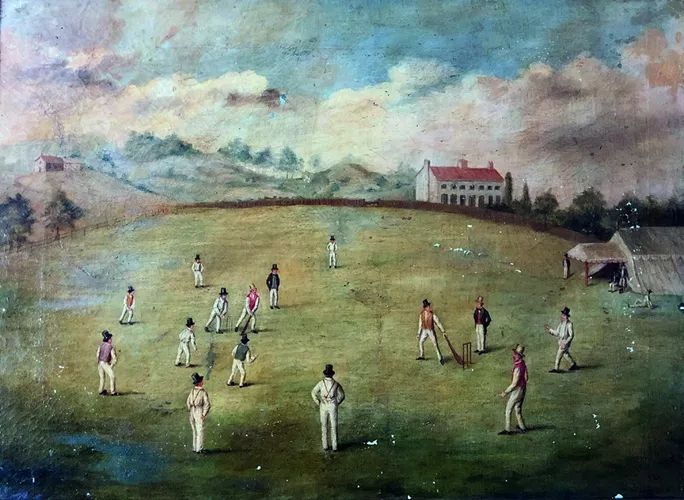
A view, very likely, based on the engraving of 1784. Note the similarity of the presentation of background features such as the cottage (left), the tent and the workhouse.
1790 – Cricket at White Conduit Fields (5) – Thomas Rowlinson
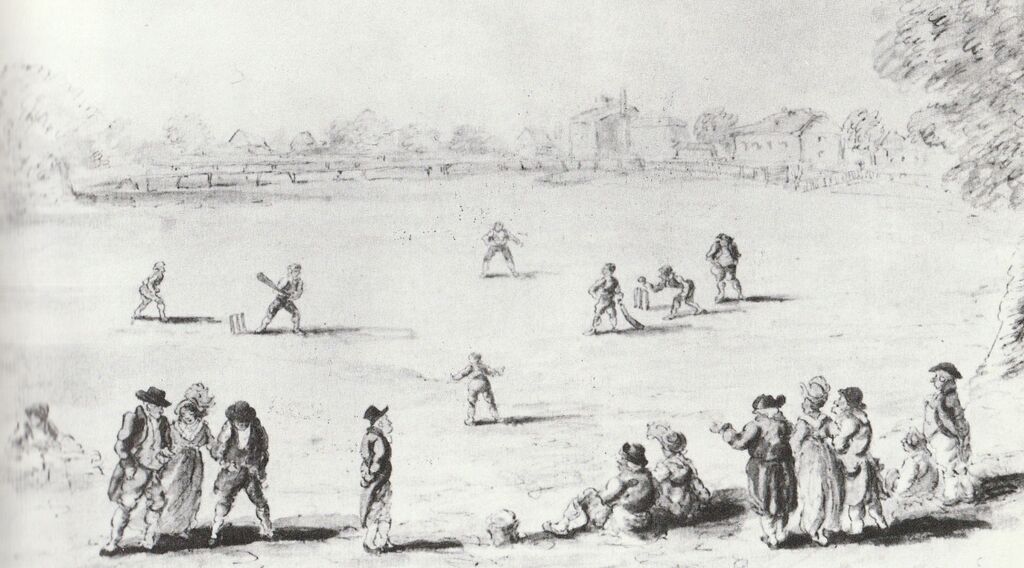
A view, very likely, based to some extenton the engraving of 1784 by Robert Dighton, although there are several differences, for example bowling is from the opposite end. However, the White Conduit buildings are fairly clear in the background. This picture though, has the element of friendly caricature.
1790 – Cricket Match At Lord’s Ground In Dorset Square
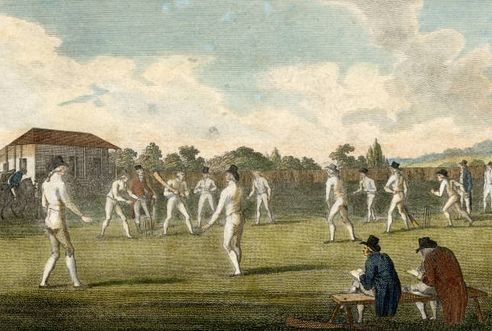
Supposedly, a 1,000 guinea contest at the Dorset Square Lord’s Ground between the Earl of Danley’s team and the Earl of Winchilsea’s. The hill in the background doesn’t however look like London – perhaps that is just artistic license.
1790 – Cricket at Mousely Hurst – James Ward
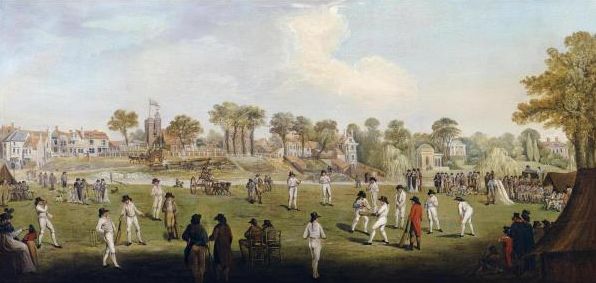
Framed landscape of Moulsey Hurst on the south bank of the River Thames. Cricket match in the foreground. Tree on far right with spectators seated in front of a white tent with Union flag. Single spectator with cane standing on far left, two seated scorers in centre of pitch. View across to north bank and Garrick’s Temple to Shakespeare and a white tower or church.
James Ward RA (23 October 1769 – 17 November 1859) was an English painter, his fame largely rests on his work as a painter of animals, and as an engraver.
1790 – A Game of Cricket – Anon
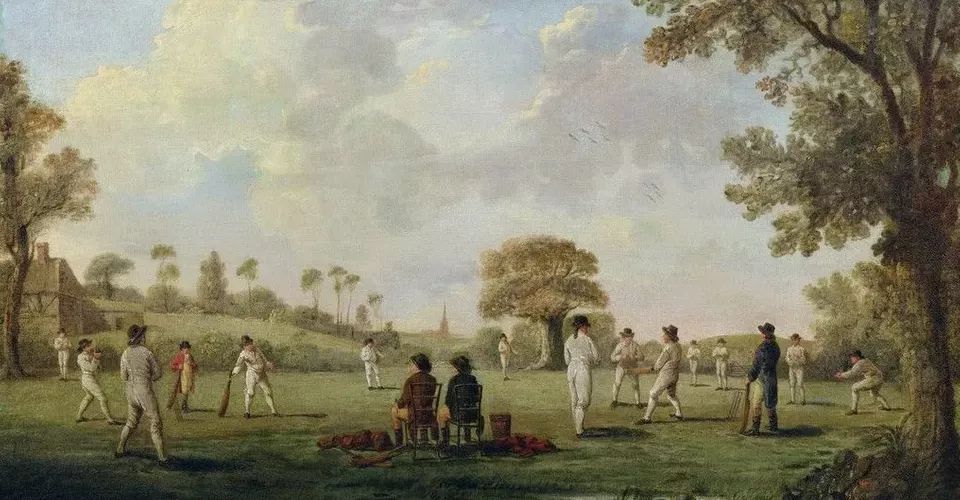
A game of cricket, 1790. Sometimes associated with Hambledon, but, in truth, location unknown, certainly the steeple in the background is not visible at Broadhalfpenny Down and neither is the cottage to the left.
The posture and clothing of many of the players, the artistic technique, the colouring, even the dimensions are strikingly similar to the Moseley Hurst painting above. For example, look at the batters, the field settings, the players hats and the use of shade in the foreground. Another feature is that the bowling is from the right of the picture, in most painting inspired by Harman, the bowling if from the right; this has the effect of placing most of the fielders (the packed off side syndrome) facing the audience instead of us seeing their backs. It seems to me that this is probably the work of James Ward as well.
1790s – A Game of Cricket – after Hayman, 1740

A Game of Cricket, supposedly at The Royal Academy Club in Marylebone Fields, now Regent’s Park. Hayman’s 1740 arrangement of the cricket field is again been recycled, fifty years after it was first made. For me, this painting seems to have a more rustic air, perhaps because the background field is more prominent and a five-bar gate has been added, albeit that the third stump in evidence. The players of both sides are uniformly attired in white breeches and yellow jackets as they are in the 1824 picture below.
1793 – Engraving of Dartmouth College, USA – Josiah Dunham
1795 – Wells Cathedral with a Game of Cricket – JMW Turner
1796 – Cricket-Match at Montpelier Gardens, Walworth – H. Alken
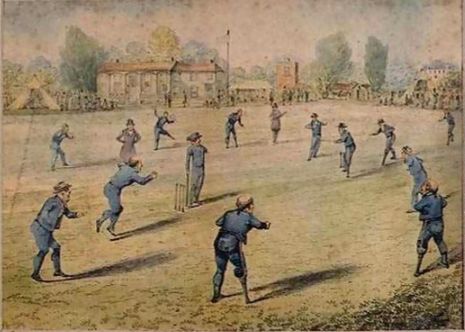
Played by eleven Greenwich Pensioners with one leg against eleven with one arm, in front of what seems a large crowd.
1799 – Bowl Fair Sir – George Woodward
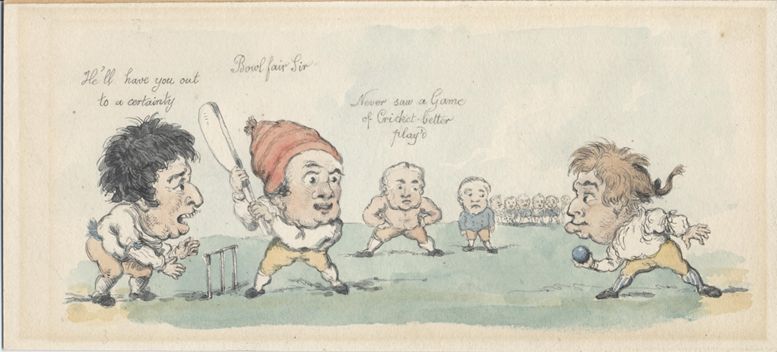
There is an earlier scene to this cartoon which I do not have. I understand that there are two men in conversation – one says ‘Well Mordecai how have you gone on upon change to day!’ The other replies ‘A very bad day’s work indeed – nothing to do!’
The cricket scene features the modern three wickets but the archaic style of curved bat. The wicket keeper, as you can see, is saying ‘He’ll have you out to a certainty’. Blatant sledging I’m afraid.
Note the large, if somewhat uniform, crowd. Perhaps they are all related.
1798 – Illustration of the game attached to the laws
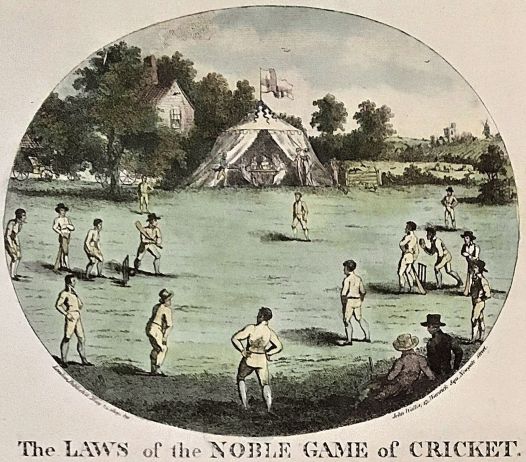
This image, clearly derived from Hayman, is used despite it now being archaic, especially the shapes of the bat. Three stumps are in use though. A tent has been added where ladies appear to be taking their rest, also a cottage emerges from the trees.
1799 – Grand Cricket Match at Swaffham, Norfolk – Artist G. Shepheard, engraving by J. Dadley.
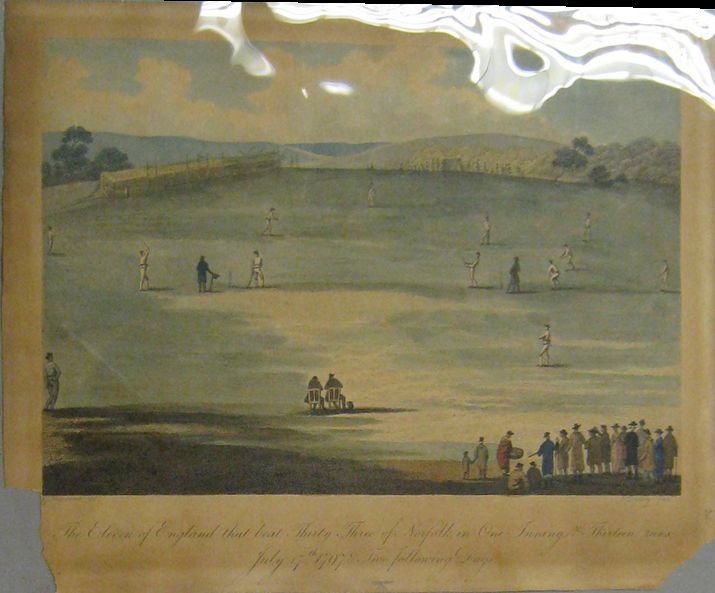
Coloured line engraving of a Cricket Match. It was published in 1799 accompanying a scorecard, and ostensibly illustrating, a match at Swaffham, Norfolk July 17th 1797 between XI of All England against 33 of Norfolk. Not sure about the hills in the background – not very Norfolk-like. Could the picture just have been borrowed? Incidentally, in their two innings, for 64 dismissals Norfolk totaled 131, highest individual score was 9. All-England reached 144 in their one innings and so won by an innings and 13 runs.
Interestingly, in his book about Hambledon, The Glory Days of Cricket, Ashley Mole identifies an engraving of this picture as being Broadhalfpenny Down and the structure on the far side as being The Lodge, a kind of pavilion for spectators. However, the structure was sited at Windmill Down, so Mote (a convicted fraudster!) is wrong in at least one respect. Could it then be Windmill Down? Certainly the background is like the Sussex Downs. The identified engraver, J Dadley was born in 1767, so if the picture is from the early 1790s (the last major match was 1795), that would be a possibility.
1800 – A cricket match on Bansted Downs, Surrey – Belanger
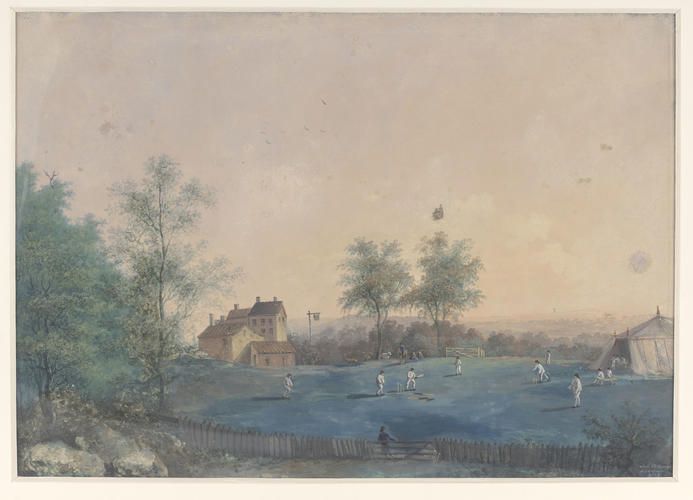
Cricketers playing in an open field, an inn to left, open landscape in background. This seems like a very authentic painting to me, composed from life rather than a pastiche of an earlier work. I like the uneven ground, the Inn sign on the boundary, the onlooker leaning against the gate and the clear underarm bowling action. I am a bit perplexed though by the large marquee – perhaps this was a great occasion, not a simple rustic scene.
1815 – Cricket at Lewes
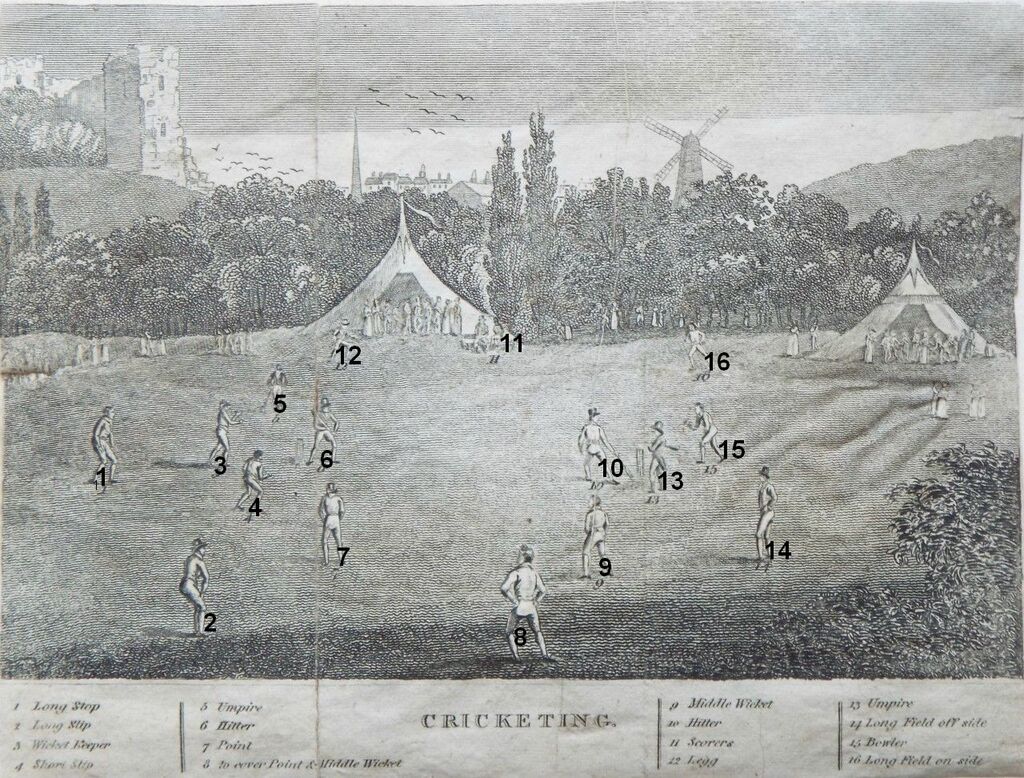
The picture of the cricket field and the annotated fielding positions are copied from the frontispiece of Rules & Instructions for Playing at the Game of Cricket, 1801, T. Boxall, the earliest book of cricket technique. With Lewes Castle and marquees added in the background this is still a great picture. The numbers on the picture and key below are as per the original, my contribution is only aimed at making them clearer.
| 1. Long stop 2. Long slip 3. Wicket keeper 4. Short slip | 5. Umpire 6. Hitter 7. Point 8. To cover point and middle wicket | 9. Middle wicket 10. Hitter 11. Scorers 12. Leg | 13. Umpire 14. Long field off side 15. Bowler 16. Long field on side |
1811 – A Cricket Match Extraordinary – Thomas Rowlinson
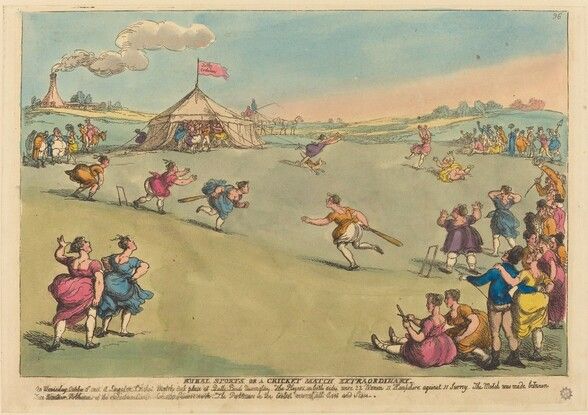
The illustration has much of the bawdy caricature about it and some have compared it to a brothel scene. You can however see the commitment of the players to the game – this is a match being played in earnest. Note also the two-stump wicket as well, which had started to be phased out in 1775, over 35 years previously.
1824 – The Cricket Match – Pollard

Outside the time scheme of this website, but included as it provides a wonderful image of top cricket early in the Nineteenth Century, a kind of summary as to where the game had arrived. Round-arm bowling was still not legal, so, the bowling is underarm. The wicket keeper appears to be taking the knee. The umpire is still holding a bat, something that was no longer necessary after the introduction of the popping crease but persisted for many decades thereafter. I imagine the batsman is about to attempt a hit to leg.

